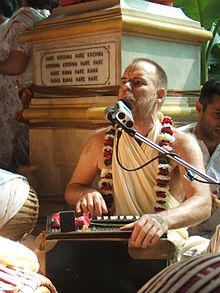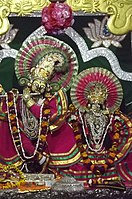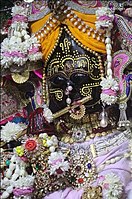world.wikisort.org - India
Vrindavan (![]() pronunciation (help·info); IAST: Vṛndāvana), also spelt Vrindaban and Brindaban,[2] is a historical city in the Mathura district of Uttar Pradesh, India. It is located in the Braj Bhoomi region and holds religious importance in Hinduism as god Krishna spent most of his childhood days in this city.[3][4][5][6] Vrindavan has about 5,500 temples dedicated to the worship of Krishna and his divine consort Radha.[7]
pronunciation (help·info); IAST: Vṛndāvana), also spelt Vrindaban and Brindaban,[2] is a historical city in the Mathura district of Uttar Pradesh, India. It is located in the Braj Bhoomi region and holds religious importance in Hinduism as god Krishna spent most of his childhood days in this city.[3][4][5][6] Vrindavan has about 5,500 temples dedicated to the worship of Krishna and his divine consort Radha.[7]
Vrindavan
Vrindaban, Brindaban | |
|---|---|
City | |
|
Clockwise from top:
Krishna Balaram Mandir, Radha Madanmohan Temple, Radha Damodar Temple, Radha Vallabh Temple, Prem Mandir (Love temple) | |
| Nicknames: City of Widows | |
 Vrindavan Location in Uttar Pradesh, India  Vrindavan Vrindavan (India) | |
| Coordinates: 27.58°N 77.7°E | |
| Country | |
| State | Uttar Pradesh |
| District | Mathura |
| Government | |
| • Type | Municipal Corporation |
| • Body | Mathura Vrindavan Municipal Corporation |
| Elevation | 170 m (560 ft) |
| Population (2011)[1] | |
| • Total | 63,005 |
| Demonym | Vrindavan wasi |
| Languages | |
| • Official | Hindi |
| • Native | Braj Bhasha dialect |
| Time zone | UTC+05:30 (IST) |
| PIN | 281121 |
| Telephone code | 0565 |
| Vehicle registration | UP-85 |
It is one of the most sacred places for Vaishnavism tradition.[3][7] Vrindavan is a significant part of the "Krishna pilgrimage circuit" which also includes Mathura, Barsana, Gokul, Govardhan, Kurukshetra, Dwarka and Puri.[8][9]
Etymology
The ancient Sanskrit name of the city, वृन्दावन (Vṛndāvana), comes from its groves of vṛndā (Holy basil) and vana (a grove or forest).[2]
Geography
Vrindavan is located at 27.58°N 77.7°E.[10] It has an average elevation of 170 metres (557 feet).[citation needed]
Yamuna river flows through the city. It is located 125 km away from Delhi and 15 km away from Mathura City.
Climate
| Climate data for Mathura (1981–2010, extremes 1974–1995) | |||||||||||||
|---|---|---|---|---|---|---|---|---|---|---|---|---|---|
| Month | Jan | Feb | Mar | Apr | May | Jun | Jul | Aug | Sep | Oct | Nov | Dec | Year |
| Record high °C (°F) | 29.6 (85.3) |
34.1 (93.4) |
40.1 (104.2) |
45.1 (113.2) |
47.1 (116.8) |
47.6 (117.7) |
44.6 (112.3) |
42.7 (108.9) |
40.6 (105.1) |
42.1 (107.8) |
35.1 (95.2) |
30.1 (86.2) |
47.6 (117.7) |
| Average high °C (°F) | 21.3 (70.3) |
24.4 (75.9) |
30.4 (86.7) |
36.6 (97.9) |
41.2 (106.2) |
41.2 (106.2) |
36.1 (97.0) |
34.6 (94.3) |
34.2 (93.6) |
33.3 (91.9) |
29.1 (84.4) |
23.3 (73.9) |
32.1 (89.8) |
| Average low °C (°F) | 6.4 (43.5) |
8.3 (46.9) |
13.2 (55.8) |
17.9 (64.2) |
23.9 (75.0) |
25.9 (78.6) |
25.5 (77.9) |
25.0 (77.0) |
23.5 (74.3) |
18.3 (64.9) |
11.6 (52.9) |
7.7 (45.9) |
17.3 (63.1) |
| Record low °C (°F) | 1.0 (33.8) |
0.5 (32.9) |
5.0 (41.0) |
7.0 (44.6) |
8.5 (47.3) |
17.0 (62.6) |
11.5 (52.7) |
17.5 (63.5) |
17.6 (63.7) |
11.5 (52.7) |
4.0 (39.2) |
2.0 (35.6) |
0.5 (32.9) |
| Average rainfall mm (inches) | 10.4 (0.41) |
13.6 (0.54) |
6.8 (0.27) |
10.1 (0.40) |
17.8 (0.70) |
35.5 (1.40) |
164.7 (6.48) |
205.2 (8.08) |
105.0 (4.13) |
18.0 (0.71) |
3.9 (0.15) |
9.0 (0.35) |
600.1 (23.63) |
| Average rainy days | 0.9 | 1.3 | 1.0 | 0.9 | 1.5 | 3.0 | 9.0 | 9.1 | 4.9 | 0.9 | 0.3 | 1.1 | 33.9 |
| Average relative humidity (%) (at 17:30 IST) | 65 | 59 | 53 | 48 | 39 | 43 | 67 | 72 | 71 | 63 | 56 | 60 | 58 |
| Source: India Meteorological Department[11][12] | |||||||||||||
Demographics
As of 2011 Indian Census, Vrindavan had a total population of 63,005, of which 34,769 were males and 28,236 were females. Population within the age group of 0 to 6 years was 7,818. The total number of literates in Vrindavan was 42,917, which constituted 68.11% of the population with male literacy of 73.7% and female literacy of 61.2%. The effective literacy rate of 7+ population of Vrindavan was 77.8%, of which male literacy rate was 83.7% and female literacy rate was 70.3%. The sex ratio is 812 females per 1000 males. The Scheduled Castes and Scheduled Tribes population was 6,294 and 18, respectively. Vrindavan had 11,637 households in 2011.[1][13]
Vrindavan lies in the cultural region of Braj.[14]
Religious heritage

Vrindavan is considered to be a sacred place for Vaisnavism tradition of Hinduism. The other prominent areas surrounding Vrindavan are Govardhana, Gokul, Nandgaon, Barsana, Mathura and Bhandirvan. Along with Vrindavan, all these places are considered to be the center of Radha and Krishna worship. Millions of devotees of Radha Krishna visit Vrindavan and its nearby areas every year to participate in number of festivals.[15] The common salutation or greetings used in Braj region by its residents is Radhe Radhe which is associated with the Goddess Radha[16] or Hare Krishna which is associated with Krishna.
History
This section needs additional citations for verification. (December 2021) |

Vrindavan has an ancient past, associated with Hindu culture and history, and was established in the 16th and 17th centuries as a result of an explicit treaty between Muslims and Hindu Emperors,[17] and is an important Hindu pilgrimage site since long.
Of the contemporary times, Vallabhacharya, aged eleven visited Vrindavan. Later on, he performed three pilgrimages of India, barefoot giving discourses on Bhagavad Gita at 84 places. These 84 places are known as Pushtimarg Baithak and since then are the places of pilgrimage. Yet, he stayed in Vrindavan for four months each year. Vrindavan thus heavily influenced his formation of Pushtimarg.

The essence of Vrindavan was lost over time until the 16th century, when it was rediscovered by Chaitanya Mahaprabhu. In the year 1515, Chaitanya Mahaprabhu visited Vrindavan, with the purpose of locating the lost holy places associated with Krishna's life.[18]
In the last 250 years, the extensive forests of Vrindavan have been subjected to urbanization, first by local Rajas and in recent decades by apartment developers. The forest cover has been whittled away to only a few remaining spots, and the local wildlife, including peacocks, cows, monkeys and a variety of bird species has been virtually eliminated.
Temples

Vrindavan, the land of Radha Krishna has about 5500 temples dedicated to them to showcase their divine pastimes.[19][20] Some of the important pilgrimage sites are[21] -
- Shri Radha Madan Mohan Temple, located near the Kalidah Ghat was built by Kapur Ram Das of Multan. One of the oldest temples in Vrindavan, it is closely associated with Chaitanya Mahaprabhu. The original deity of Madan Gopal was shifted from the shrine to Karauli in Rajasthan for safekeeping during Aurangzeb's rule. Today, a replica of the original (deity) is worshipped at the temple
- Sri Radha Raman Mandir, constructed at the request of Gopala Bhatta Goswami and houses a saligram deity of Krishna as Radha Ramana, alongside Radha.[22]
- Banke Bihari Temple, built in 1862[23] after the image of Banke-Bihari was discovered in Nidhivan by Swami Haridas.
- Radha Vallabh Temple is one of the ancient temple of Vrindavan. It was constructed in 1585 AD and was the first temple made up of red sandstones.[24]
- Radha Damodar Temple is a Gaudiya Vaishnavism temple, which is dedicated to Radha Krishna and was constructed in 1542 CE.[25]
- Sri Krishna-Balarama Temple was built by the International Society for Krishna Consciousness (ISKCON) in Raman-Reti.[26] The principal deities of this temple are Krishna and Balaram, with Radha–Shyamasundar and Gaura-Nitai alongside. Adjoining the temple is the samadhi of A. C. Bhaktivedanta Swami Prabhupada, the founder of ISKCON, built in pure white marble.
- Prem Mandir is a spiritual complex situated on a 54-acre site on the outskirts of Vrindavan dedicated to divine love. The temple structure was established by spiritual guru Kripalu Maharaj.[27] The main structure built in marble and figures of Krishna cover the main temple.[28]
- Vrindavan Chandrodaya Mandir is housed in a modern geodesic structure with a traditional gopuram based on Khajuraho style of architecture. It is being built by one of the ISKCON factions based in Bangalore.[29] At cost of ₹300 crore (US$38 million) it will be the tallest temple in world on completion.
Transportation
Road
Vrindavan is well connected by roads and is connected to Delhi by National Highway (NH) 44 of the Golden Quadrilateral network. Earlier it was NH 2.[5]
129 km from New Delhi
117 km from Gurgaon
54 km from Agra
9 km from Mathura
While in Vrindavan, battery powered e-rickshaw are available for commuting within city-limits.
Rail
- BDB/Vrindavan is on the Mathura-Vrindavan MG link.
- VRBD/Vrindavan Road is on the Agra-Delhi chord.
Flight
Nearest Airports are Agra Airport and New Delhi International Airport.
City of Widows
Vrindavan is also known as the "city of widows"[30][31][32] due to the large number of widows who move into the town and surrounding area after losing their husbands. There are an estimated 15,000 to 20,000 widows. The widows come from states of West Bengal, Assam and Odisha.[33][34] Many spend time singing bhajan hymns at bhajanashrams. An organization called Guild of Service was formed to assist these deprived women and children.[30][34] According to a survey report prepared by the government, several homes run by the government and different NGOs for widows.[35]
Gallery
- Keshi Ghat on banks of the Yamuna river
- Rangaji Temple of Vrindavan
- Prem Mandir, Vrindavan
- Krishna Balaram Mandir
- Radha Madan Mohan Temple, Vrindavan
- Wall art of the name Radha
- Pagal Baba Temple
See also
- Gokul
- Mathura
- Barsana
- Nandgaon
- Radha Kund
- Kusum Sarovar
- Radha Rani Temple
- Banke Bihari Temple
- Radha Raman Temple
- Radha Madan Mohan Temple, Vrindavan
- Nidhivan
- Radha Krishna
References
- "Census of India: Vrindavan". www.censusindia.gov.in. Retrieved 9 October 2019.
- "Brindaban". The Imperial Gazetteer of India. 1909.
- Hawley, John Stratton (2020). Krishna's Playground: Vrindavan in the 21st Century. Oxford; New York: Oxford University Press. ISBN 978-0190123987.
- "UP gets first officially designated 'teerth sthals' in Vrindavan and Barsana". Times of India. 27 October 2017.
- "NHAI". Archived from the original on 4 December 2016. Retrieved 14 February 2018.
- Keene, Henry George (1899). "Bindrabun". A Handbook for Visitors to Agra and Its Neighbourhood. Thacker, Spink & Co. pp. 98–106.
- Gopal, Madan (1990). K.S. Gautam (ed.). India through the ages. Publication Division, Ministry of Information and Broadcasting, Government of India. p. 176.
- "Development of Ramayana and Krishna Circuits". pib.gov.in. Retrieved 15 August 2022.
- Bhattacharya, G. (2003). Vrindavan. Oxford Art Online. Oxford University Press. doi:10.1093/gao/9781884446054.article.t090249.
- "Maps, Weather, and Airports for Vrindavan, India". www.fallingrain.com. Retrieved 6 December 2019.
- "Station: Mathura Climatological Table 1981–2010" (PDF). Climatological Normals 1981–2010. India Meteorological Department. January 2015. pp. 481–482. Archived from the original (PDF) on 5 February 2020. Retrieved 22 September 2020.
- "Extremes of Temperature & Rainfall for Indian Stations (Up to 2012)" (PDF). India Meteorological Department. December 2016. p. M220. Archived from the original (PDF) on 5 February 2020. Retrieved 22 September 2020.
- Jayant Pandurang Nayaka, Syed Nurullah (1974). A students' history of education in India (1800–1973) (6 ed.). Macmillan.
{{cite book}}: CS1 maint: uses authors parameter (link) - Lucia Michelutti (2002). "Sons of Krishna: the politics of Yadav community formation in a North Indian town" (PDF). PhD Thesis Social Anthropology. London School of Economics and Political Science University of London. p. 49. Retrieved 20 May 2015.
- Klaus Klostermaier (2007). A Survey of Hinduism. State University of New York Press; 3 edition. p. 204. ISBN 978-0-7914-7081-7.
The center of Krishna-worship has been for a long time Brajbhumi, the district of Mathura that embraces also Vrindavana, Govardhana, and Gokula, associated with Krishna from the time immemorial. Many millions of Krishna bhaktas visit these places every year and participate in the numerous festivals that re-enact divine scenes from Krishna's life on Earth, of which were spent in those very places
Vrinda means Tulsi (A sacred species of flora) and van as forest, therefore Vrindavan is a holy forest of Tulsi. Vijaypal Baghel, known as GreenMan is promoting, planting and farming Tulsi in mass around the Vrindavan. - Lynch, Owen M. (31 December 1990). "ONE. The Social Construction of Emotion in India". Divine Passions. University of California Press. pp. 3–34. doi:10.1525/9780520309753-002. ISBN 978-0-520-30975-3.
- "Watch | John Stratton Hawley on His Latest Book on 'Krishna's Playground'". The Wire. 25 January 2020. Retrieved 3 March 2020.
- "Discovery of Vrindavan by Chaitanya Mahaprabhu". Archived from the original on 23 January 2011. Retrieved 6 December 2019.
- Rājaśekhara Dāsa (2000). The Color Guide to Vṛndāvana: India's Most Holy City of Over 5,000 Temples. Vedanta Vision Publication.
- Seven main temples of Vrindavan, Vrindavantoday.org
- Anand, D. (1992). "Temples and Places". Krishna: The Living God of Braj. Abhinav Publications. pp. 42–86. ISBN 978-81-7017-280-2.
- "Sri Radha Raman in Vrindavan". www.salagram.net. Retrieved 6 December 2019.
- "Banke-Bihari Temple website". Archived from the original on 4 March 2016. Retrieved 6 December 2019.
- "Chapter 7. Cross-Cultural Dynamics of Mystical Emotions in Vrindaban". The Hare Krishnas in India. Princeton University Press. 14 July 2014. pp. 176–198. doi:10.1515/9781400859894.176. ISBN 978-1-4008-5989-4.
- "Radha Damodar Mandir, Vrindavan - Info, Timings, Photos, History". TemplePurohit - Your Spiritual Destination | Bhakti, Shraddha Aur Ashirwad. Retrieved 2 September 2021.
- "ISKCON Vrindavan - Home".
- "Famous Krishna Temples in India". Zee News. 20 August 2013. Retrieved 6 December 2019.
- Kumar, Mayank (13 February 2012). "Kripaluji Maharaj's Prem Mandir will be inaugurated on 17 February". Aaj Ki Khabar. Archived from the original on 30 March 2014. Retrieved 29 March 2014.
- "News18.com: CNN-News18 Breaking News India, Latest News Headlines, Live News Updates". News18. Archived from the original on 16 March 2014. Retrieved 6 December 2019.
- "India's widows live out sentence of shame, poverty". Archived from the original on 29 November 2006. Retrieved 25 March 2007.
- "The Indian town with 6,000 widows". BBC News. 2 May 2013. Retrieved 12 January 2021.
- "The widows of Vrindavan". cnbctv18.com. 8 March 2019. Retrieved 12 January 2021.
- "Catalyst Magazine: Moksha: the widows of Vrindavan". Archived from the original on 3 April 2007. Retrieved 25 March 2007.
- "Shunned from society, widows flock to city to die". CNN. 5 July 2007. Retrieved 5 July 2007.
- "Sulabh dons mantle". Retrieved 6 December 2019.
External links
![]() Vrindavan travel guide from Wikivoyage
Vrindavan travel guide from Wikivoyage
На других языках
[de] Vrindavan
Vrindavan (Hindi .mw-parser-output .Deva{font-size:120%}@media all and (min-width:800px){.mw-parser-output .Deva{font-size:calc(120% - ((100vw - 800px)/80))}}@media all and (min-width:1000px){.mw-parser-output .Deva{font-size:100%}}वृन्दावन) ist eine etwa 70.000 Einwohner zählende Stadt im Distrikt Mathura des indischen Bundesstaats Uttar Pradesh. Für die Anhänger des Hindu-Gottes Krishna ist sie eine heilige Stadt.- [en] Vrindavan
[ru] Бриндабан
Бриндабан[1][2] или Вриндаван (хинди वृन्दावन, IAST: Vṛndāvan) — город в округе Матхура штата Уттар-Прадеш, Индия. Является святым местом паломничества для последователей вайшнавизма. На месте современного Вриндавана в древности находился лес, в котором согласно верованиям индуистов Кришна во время своего земного воплощения 5000 лет назад проводил свои божественные игры. Вриндаван находится в 15 километрах от города Матхуры, который принято считать местом рождения Кришны. Вблизи города пролегает автострада Агра — Дели[3].Другой контент может иметь иную лицензию. Перед использованием материалов сайта WikiSort.org внимательно изучите правила лицензирования конкретных элементов наполнения сайта.
WikiSort.org - проект по пересортировке и дополнению контента Википедии












